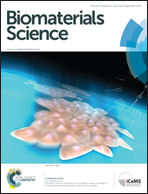Topographical modulation of macrophage phenotype by shrink-film multi-scale wrinkles†
Abstract
The host immune response to foreign materials is a major hurdle for implanted medical devices. To control this response, modulation of macrophage behavior has emerged as a promising strategy, given their prominent role in inflammation and wound healing. Towards this goal, we explore the effect of biomimetic multi-scale wrinkles on macrophage adhesion and expression of phenotype markers. We find that macrophages elongate along the direction of the uniaxial wrinkles made from shape memory polymers, and express more arginase-1 and IL-10, and less TNF-α, suggesting polarization towards an alternatively activated, anti-inflammatory phenotype. Materials were further implanted in the subcutaneous space of mice and tissue surrounding the material evaluated by histology and immunohistochemistry. We found that material surface topography altered the distribution of collagen deposition in the adjacent tissue, with denser collagen tissue observed near flat materials when compared to wrinkled materials. Furthermore, cells surrounding wrinkled materials exhibited higher arginase-1 expression. Together these data suggest that wrinkled material surfaces promote macrophage alternative activation, and may influence the foreign body response to implants.


 Please wait while we load your content...
Please wait while we load your content...